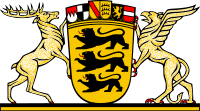Wikipedia:WikiProject Germany/Portal:Baden-Württemberg
Introduction

Baden-Württemberg (/ˌbɑːdən ˈvɜːrtəmbɜːrɡ/ BAH-dən VURT-əm-burg, German: [ˌbaːdn̩ ˈvʏʁtəmbɛʁk] ), commonly shortened to BW or BaWü, is a German state (Land) in Southwest Germany, east of the Rhine, which forms the southern part of Germany's western border with France. With more than 11.07 million inhabitants across a total area of nearly 35,752 km2 (13,804 sq mi), it is the third-largest German state by both area (behind Bavaria and Lower Saxony) and population (behind North Rhine-Westphalia and Bavaria). As a federated state, Baden-Württemberg is a partly-sovereign parliamentary republic. The largest city in Baden-Württemberg is the state capital of Stuttgart, followed by Mannheim and Karlsruhe. Other major cities are Freiburg im Breisgau, Heidelberg, Heilbronn, Pforzheim, Reutlingen, Tübingen, and Ulm.
What is now Baden-Württemberg was formerly the historical territories of Baden, Prussian Hohenzollern, and Württemberg. Baden-Württemberg became a state of West Germany in April 1952 through the merger of South Baden, Württemberg-Baden, and Württemberg-Hohenzollern. These three states had been artificially created by the Allies after World War II out of the existing traditional states by their separation over different occupation zones.
Baden-Württemberg is especially known for its strong economy with various industries like car manufacturing, electrical engineering, mechanical engineering, the service sector, and more. It has the third-highest gross regional product (GRP) in Germany. Part of the Four Motors for Europe and located in the Blue Banana, some of the largest German companies are headquartered in Baden-Württemberg, including Mercedes-Benz Group, Schwarz Group, Porsche, Bosch and SAP.
The sobriquet Ländle, a diminutive of the word Land in the local Swabian, Alemannic and Franconian dialects, is sometimes used as a synonym for Baden-Württemberg. (Full article...)
Selected article

The coat of arms of Baden-Württemberg was determined after the merging of the former German states Baden, Württemberg-Baden and Württemberg-Hohenzollern, that were divided due to different occupying forces after World War II, in 1952. The creation of the state was not without controversies and thus only the state colours black and gold were determined in 1952, but not yet the arms. The latter were only regulated in the Gesetz über das Wappen des Landes Baden-Württemberg (Law on the Coat of Arms of Baden-Württemberg) of 3 May 1954. Its use is moreover regulated by an order dated 2 August 1954. It was designed by Fritz Reinhardt.
The shield shows three black lions with red tongues on a golden background. The arms refer to the coat of arms of the Duke of Swabia whose House of Hohenstaufen had used these arms. The name of Suabia had long been discussed for use with the newly created state but it failed to be adopted due to resistance from parts of Baden.
Selected biography

Erwin Rommel (15 November 1891 – 14 October 1944), popularly known as the Desert Fox, was a senior German Army officer during World War II. Rommel was a highly decorated officer in World War I and was awarded the Pour le Mérite for his actions on the Italian Front. In World War II, he distinguished himself as the commander of the 7th Panzer Division during the 1940 invasion of France. His leadership of German and Italian forces in the North African Campaign established his reputation as one of the most able commanders of the war, and earned him the appellation of "the Desert Fox". He later commanded the German forces opposing the Allied cross-channel invasion of Normandy in June 1944. Rommel supported the Nazi seizure of power and Adolf Hitler, although his attitude towards Nazi ideology and level of knowledge in the regime's crimes remain a matter of debate among scholars. In 1944, Rommel was implicated in the 20 July plot to assassinate Hitler. Due to Rommel's status as a national hero, Hitler desired to eliminate him quietly.
State facts
- Nickname: Ländle
- Capital: Stuttgart
- Minister-president: Winfried Kretschmann
- Governing parties: Greens / CDU
- Total area: 35,751 km2 (13,804 sq mi)
- Population: 10,879,618 (2015)
- Founded: April 25, 1952
- Website: www.baden-wuerttemberg.de
Selected image
Did you know?

- ...that the Wilhelma in Stuttgart is Europe's only large combined zoological and botanical garden, and is home to over 8,000 animals representing more than 1,000 different species, as well as more than 5,000 species of plants..
- ...that Albert Einstein was born in the Kingdom of Württemberg? Einstein is best known in popular culture for his mass–energy equivalence formula E = mc2. He received the 1921 Nobel Prize in Physics for his "services to theoretical physics".
Subcategories
Selected panorama
 |
Heidelberg is a college town in Baden-Württemberg situated on the river Neckar in south-west Germany. At the 2015 census, its population was 156,257, with roughly a quarter of its population being students. A former residence of the Electorate of the Palatinate, Heidelberg is a popular tourist destination due to its romantic cityscape, including Heidelberg Castle, the Philosophers' Walk, and the baroque style Old Town.
Topics
Related portals
Associated Wikimedia
The following Wikimedia Foundation sister projects provide more on this subject:
-
Commons
Free media repository -
Wikibooks
Free textbooks and manuals -
Wikidata
Free knowledge base -
Wikinews
Free-content news -
Wikiquote
Collection of quotations -
Wikisource
Free-content library -
Wikiversity
Free learning tools -
Wikivoyage
Free travel guide -
Wiktionary
Dictionary and thesaurus
















